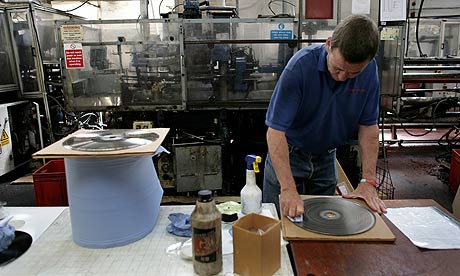How to make a vinyl record
Vinyl may have been overtaken by CDs and downloads but it still has passionate fans, with the last major plant in the Uk pressing about 25,000 records a week on its 40-year old presses
Forty-year-old record presses, installed by EMI in the 70s vinyl heyday, grind noisily away, oozing hydraulic oil on to the floor. Long pipes run the length of the factory floor, carrying steam to power the presses. It's as if the digital age has never occurred.
Hi-tech this is not, but über-cool niche it certainly is. I'm on an industrial estate in Hayes, Middlesex. This was once the EMI vinyl manufacturing plant, until the record label sold it off in 2001, and it became the Vinyl Factory. In the 70s this plant pressed 1m records a week. It's now the last major vinyl plant in the UK and presses around 25,000 records a week.
General manager Roy Mathews began work here straight after school as an apprentice. That was 50-odd years ago. In those days the Beatles and Pink Floyd used to trail through the factory, keen to see their records (Sergeant Pepper's Lonely Hearts Club Band and The Dark Side of the Moon no less) being pressed. Mathews met them all, but no such thing happens today. The stars don't do factory visits any more; it's a reality too far.
But while CDs and downloads have taken over the market, vinyl itself has never lost its credibility. Devotees cite its superior sound quality and the personal, tactile relationship one develops with the big black disc and accompanying artwork. The Vinyl Factory's mission statement is: "Music is a physical experience." What's more, vinyl is experiencing a resurgence. Massive Attack, Grace Jones, The Pet Shop Boys and Mumford & Sons have all pressed limited runs here.
Mathews pulls out a black LP called the "lacquer". This is the master cut that the Vinyl Factory receives from Abbey Road Studios. It's an aluminium disc coated in acetate lacquer into which an analogue signal has been cut using a heated diamond stylus. At this point, the disc is a soft facsimile of the final record.
We move to the hub of the factory floor, where an assistant cleans the surface of the lacquer using distilled water and then softly brushes it using soap solution to remove any grease before placing it in the silver plating tank, where mechanical jets shower the disc with a thin layer of silver to make it electrically conductive.
Before our eyes the disc gathers a beautiful silver sheen. It is then placed in an electroplating bath where, over three hours, individual nickel molecules attach themselves to the silver. The resulting "master" is washed and separated from the original lacquer. As this master is now a negative imprint, another positive nickel copy is made, called the "mother".
The mother copy is played and checked for faults. All being well, negative nickel "stampers" are then produced from the mother. These are cleaned and used to press the final run of records.
Mother, master, stamper, positive, negative: I am initially bemused by Mathew's flood of terminology. To him it's clearly second nature; after half a century, vinyl manufacturing is stamped on his brain indelibly.
A pile of paper record labels are placed in a record press. The vinyl arrives in the form of black PVC pellets contained in a large vat with spidery tubes running out of it and into several large presses. The pellets are sucked up the tubes and into the sealed press and melted at high temperature. A sausage of black vinyl is squirted out, into a circular block, which is sandwiched between two record labels before being flattened between the A and B side stampers. The excess PVC that seeps out of the sides is trimmed off and dumped in a bin. It is fearsomely hot to touch.
The press then produces a perfectly round, covetable finished disc that it slots into a sleeve before depositing it in an adjacent box. Once a run is complete, the used stamper is removed and the next one is cleaned with pressurised air to get rid of any grit, slotted into place and screwed in, ready for the next run.
Warm, noisy and greasy, these old machines keep on keeping on. The pristine records they produce belie the frankly rather clapped-out looking machines that continue to manufacture them. Old school engineering triumphs here. Nothing has changed. But why tinker with perfection?


No comments:
Post a Comment